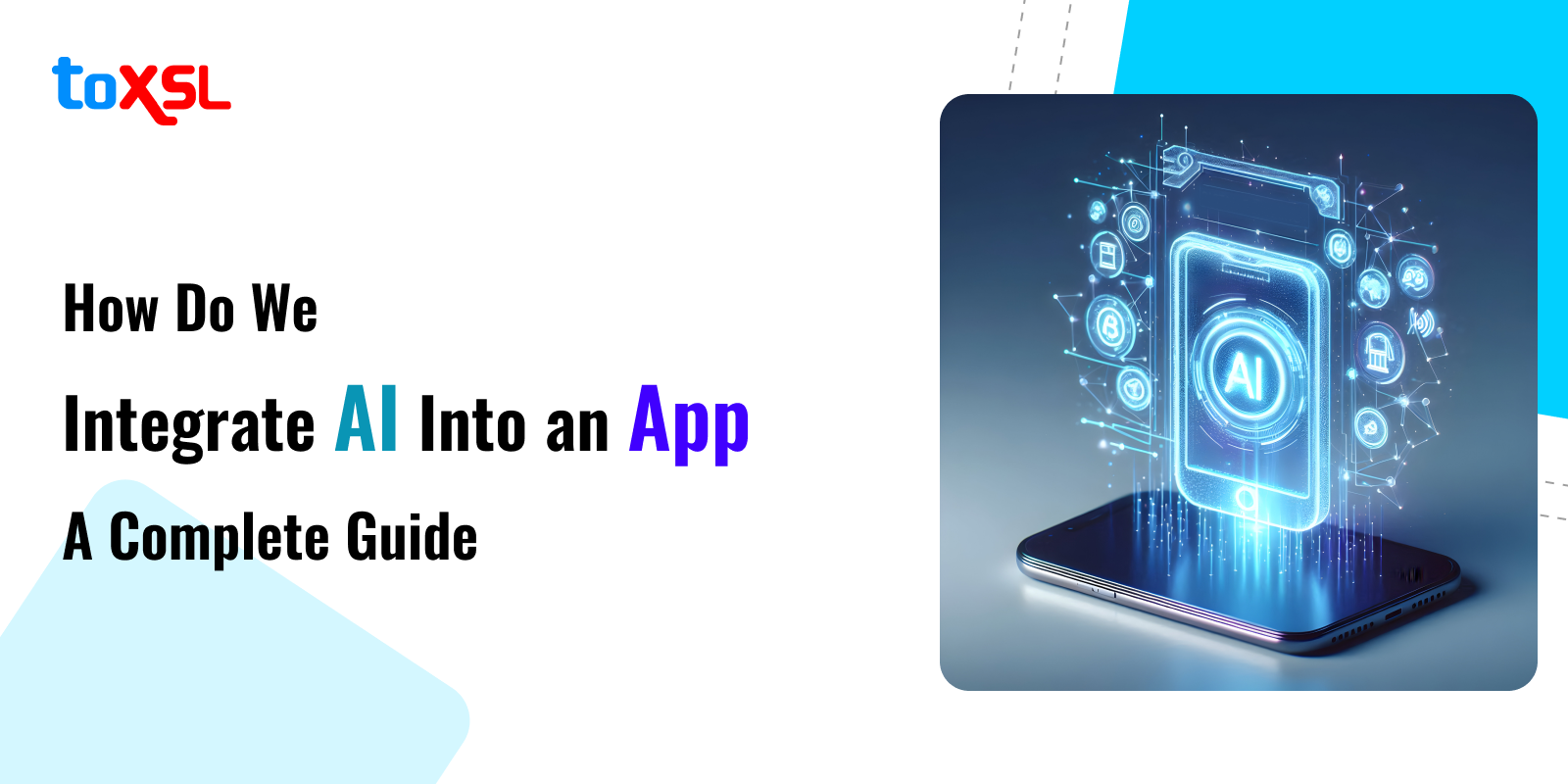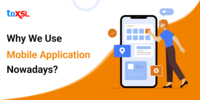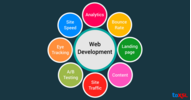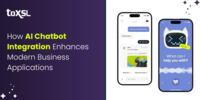- Dec 04, 2025
Share this post on:

Do you want to integrate AI into an app? Want to look for ways that can help you streamline processes? Artificial Intelligence is changing the future of app development. Integrating AI into apps is no longer an option but a necessity for businesses, helping them stay ahead of their competition. In this blog, we will explore reasons businesses should integrate AI into their existing apps.
According to McKinsey, AI could add up to $25.6 trillion to the world’s economy. Moreover, according to a report by Statista, by 2030, the market size is expected to reach nearly $2 trillion. Over 54% of companies are using Gen AI in their businesses.
AI has successfully revolutionized industries, helping businesses expand at a greater level. Integrating AI with existing operations can help businesses obtain an incredible competitive edge. This not only allows businesses to streamline processes and give them a competitive edge but also enriches individual experiences. But how do businesses integrate AI into apps? Well, to learn more about the steps involved in the integration of AI in business, keep reading the blog.
Reasons why businesses should integrate AI
Wondering why should businesses integrate AI into their existing systems? A survey conducted by Mckinsey states that 79% of their participants reported using Generative AI in some way, while 22% indicated that they use it in their work. In this section, we will cover the reasons that make AI integration an absolute necessity. Here are a few reasons:
1. Customization: As per a report provided by Accenture, 91% of customers prefer to shop from brands that acknowledge and recall them. So, if you are looking for ways that can help you create personalized brand for your customers, integrating AI is the best option for you. Businesses can do data analysis and develop brands as per their customers’s preferences and behaviors.
2. User Engagement: Do you know acquiring new customers is five times more expensive than retaining existing ones? Moreover, retaining customers can help businesses generate revenue by 25–95%. AI can help businesses develop personalized brands and products that can give customers a sense of acceptance, helping businesses retain them. This, in turn, enhances businesses revenue and customers' trust.
3. Data Insights: What is better than knowing your customers’s choices in advance? AI helps businesses understand the latest trends and insights from the data. This helps businesses make informed decisions regarding their brand or the new launch of any product. Having data insights can help you improve businesses, enhancing their revenue.
4. Cost Reduction: AI can help businesses reduce costs by offering proper product maintenance and support. Integrating AI with business processes can help you build smarter products by helping you use resources in a better way. This helps businesses predict when things might not work, helping them work on such things in advance. AI integration not only helps businesses reduce costs but also helps them save cost. With the right tools, an AI app builder can make it easier to implement these solutions efficiently and effectively.
How to Integrate AI into Apps: A Step-by-Step Guide
We have discussed the reasons to integrate AI into your existing systems, but the question remains: how do you integrate AI into apps? In this section, we will give you deep insights about the steps involved in iterating AI in apps. Here are a few steps that you should take before integrating AI into an app.
1. Identify Needs: Before jumping into the process of AI integration, it is recommended to define your goals clearly. Decide what kind of experience you want our customers to have. Ensure that you are able to answer questions such as: How can AI integration help you achieve your goals? Will this integration enhance the speed of your business? Ensure that the AI integration does not affect the speed of your operations. Hence, before hiring the dedicated AI app developers, ensure to discuss your needs with them.
2. Data Evaluation: The quality of the data matters the most when it comes to developing AI or integrating AI into your existing systems. Before moving forward with development, ensure that your data is filtered, evaluated, and processed. Hence, this step guarantees that you have gathered all the essential data and that it is properly formatted. You may consider hiring AI engineers to assist you in quickly improving your data.
3. Curate the app’s UI/UX: Your mobile app needs to be visually appealing and intuitive, as it captivates the audience and draws them in. Implementing a smart UI and UX design not only enhances customer loyalty but also ensures that users can seamlessly interact with your AI-powered product. Your Business Analysis (BA) team can help you conduct research and assess the company's immediate requirements. By using this information, the design team can utilizes these wireframes as a blueprint. This process also involves selecting visual components, fonts, and color palettes that align with the brand's vision, creating an engaging user experience.
4. Construct an AI Model: Once you select a development platform and your technology stack, you can start handling the key question: how to create your own AI solutions? This process involves developing the neural network, using the dataset for training, and performing coding and quality tests to optimize the application. If you're focusing on Generative AI solutions, consider hiring dedicated AI developers to leverage existing solutions for integration into your app. Ensure to explore frameworks and APIs that provide robust features suitable for your current project.
5. Improve your Algorithms: Ensure to evaluate your mobile app after integrating artificial intelligence (AI). Verify that the app functions as required and make continuous improvements for enhanced performance. However, data analytics can assist you in enhancing the accuracy of your AI models.
6. AI Integration: Once the artificial intelligence (AI) framework has been developed and tested, it’s time to integrate it into your mobile app. Depending on the system in use, you may need to take additional steps, such as creating a custom APIor integrating an existing one. Also, ensure that the prototype is secure and fully operational before moving into production.
7. Know user Needs: User feedback offers the clearest insights into the functionality of your AI-driven mobile app. Feedback from users is crucial for evaluating the app's performance. Pay close attention to the reviews and ratings, and use this information to improve your strategy for optimizing the app's functionality. Additionally, consider partnering with AI development service providers who have a deep understanding of what it takes to create an AI system.
AI Integration in Apps: Challenges
As with any other technology, AI integration comes with lots of challenges. But what are the challenges in AI integration? Well, we have curated the most common challenges that businesses can face during AI integration.
1. Reliance on third-party services: Not every business creates AI apps. Mos businesses simply integrate with external platforms such as GPT models and LLMs. If any of these services face issues, the apps using these functionalities will be disrupted. Hence, dependence on these third-party services is one of the biggest challenges businesses can face.
2. Prompt Engineering: Prompt engineering is essential for effective results. It involves designing inputs for AI models to achieve particular outputs. Nevertheless, this entire process requires significant time and effort to adjust the model and refine these prompts. This is because prompts directly impact the AI's performance in your application.
3. Data Challenges: High-quality data plays the most important role in ensuring the success of AI integration. If the data is insufficient or of poor quality, you may have to either acquire more data or engage in data labeling. And this process of data labeling involves specialists who manually annotate the data to train the AI model, increasing the cost and demanding more time. Furthermore, additional efforts might be necessary to anonymize or encrypt sensitive information.
4. Resources and Costs: Training a foundational AI model can be a costly endeavor. For example, OpenAI reportedly spent around $4.6 million to train GPT, which was then adapted to develop ChatGPT. Instead of building a model from the ground up, it is frequently more practical and cost-effective to utilize and fine-tune existing pre-trained models to meet specific business requirements.
Final Words
Integrating AI into your app helps businesses enhance the capabilities of their products. Even though no one can tell how the market is going to behave in the future, with the help of AI, you can predict the possibilities and act accordingly. The future seems to hold greater possibilities in the world of technology; hence, integrating AI into your apps can open doors to new opportunities. Hence, if you are looking to integrate AI into your apps, it is advised to seek the help of an AI app development company. Expert AI developers have knowledge about the integration of AI into existing apps or products.
So, if you are thinking of enhancing business by integrating AI into your existing apps, look no further than ToXSL Technologies. With years of experience in business, we have offered next-generation innovative Artificial Intelligence solutions to businesses worldwide. With Artificial Intelligence, the future of technology is bright, and so is yours. Contact our team today and unlock the possibilities with our AI services.












